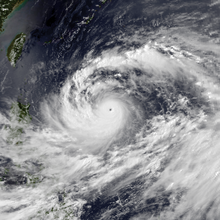 Typhoon Thelma at peak intensity on July 11 | |
| Meteorological history | |
|---|---|
| Formed | July 6, 1987 |
| Dissipated | July 16, 1987 |
| Very strong typhoon | |
| 10-minute sustained (JMA) | |
| Highest winds | 185 km/h (115 mph) |
| Lowest pressure | 915 hPa (mbar); 27.02 inHg |
| Category 4-equivalent super typhoon | |
| 1-minute sustained (SSHWS/JTWC) | |
| Highest winds | 240 km/h (150 mph) |
| Overall effects | |
| Fatalities | 138 confirmed |
| Damage | $272 million |
| Areas affected | Philippines, South Korea, Japan |
Part of the 1987 Pacific typhoon season | |
Typhoon Thelma, known in the Philippines as Typhoon Katring, was the first super typhoon to form in the 1987 Pacific typhoon season. Forming from the monsoon trough in the Philippine Sea, Thelma was first designated as a tropical cyclone on July 7. After moving north, Thelma turned west, while remaining poorly organized. It finally attained typhoon status on July 9, soon after developing an eye, and began to intensify at a brisker clip. During the evening of July 10, Thelma attained maximum intensity while well to the east of the northern Philippines. It also turned sharply northward in response to a trough, slowly weakening. On July 15, Typhoon Thelma, now greatly reduced in intensity, struck the south coast of South Korea. The next day, Thelma rapidly dissipated, shortly after emerging into the Sea of Japan.
Although Thelma remained well offshore the Philippines, around 500 homes were swept away due to flooding, which left more than 3,500 people homeless. A total of 130 people were rescued after a vessel sunk. Nationwide, 12 people perished. In Japan, the typhoon brought heavy rains that was responsible for property damage in 19 prefectures. Throughout the country, three people died while around 1,000 dwellings were flooded.
Considered by the media to be the worst typhoon to hit South Korea in 28 years, Thelma brought widespread damage throughout the nation. Over 50 boats sunk or were otherwise damaged in Pusan, resulting in the loss of 150 people at sea. Overall, 8,881 buildings were damaged or destroyed across South Korea. Approximately 6,500 houses were demolished, leaving about 29,000 people without shelter. In addition, about 62,000 ha (153,205 acres) of farmland were flooded. A total of 3,879 vessels were damaged, including 2,829 that were destroyed or seriously damaged. This represented around 4% of the country's fishing fleet. Nationwide, 123 people were killed, 212 were rendered missing, and 114 were injured. In addition, damage totaled $272 million, of which property damage totaled $222 million.[nb 1] Due to the impact of the typhoon to South Korea, over 167,000 government workers, including thousands of military reserves, were mobilized to search for survivors and repair damage. In response of 100 farmers protesting over the slow timing of aid, the South Korean government agreed to provide $237 million in aid.
Cite error: There are <ref group=nb> tags on this page, but the references will not show without a {{reflist|group=nb}} template (see the help page).
© MMXXIII Rich X Search. We shall prevail. All rights reserved. Rich X Search
